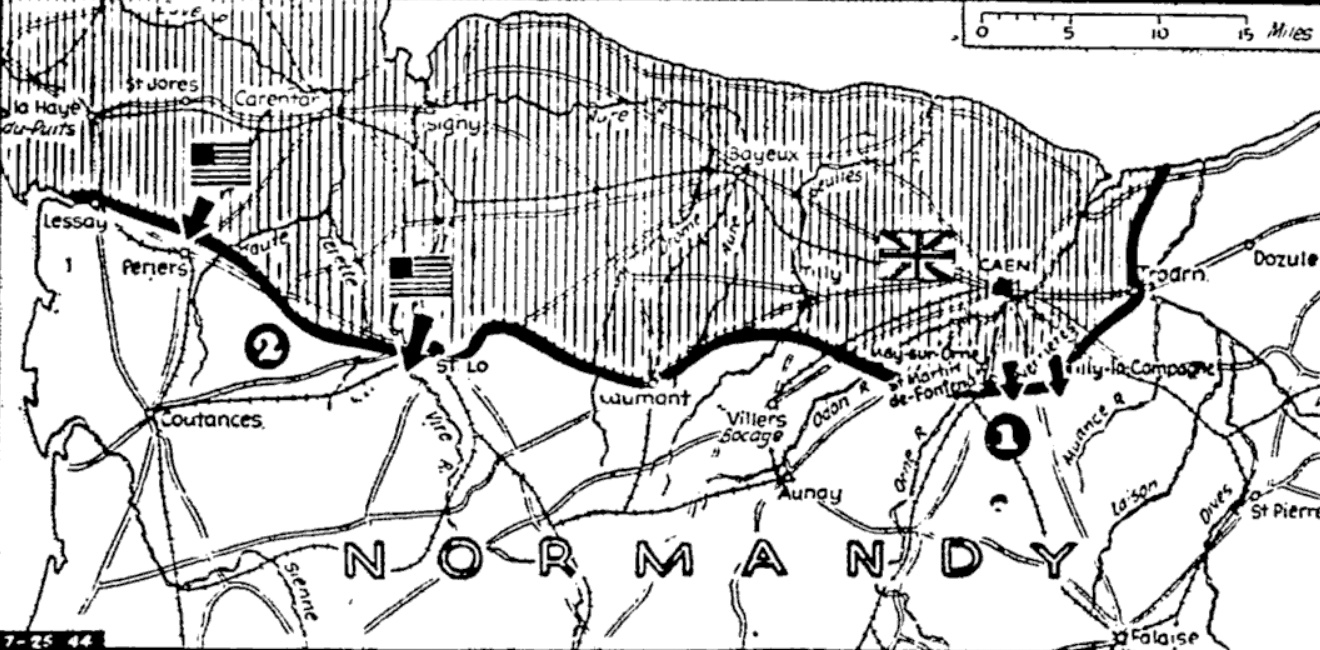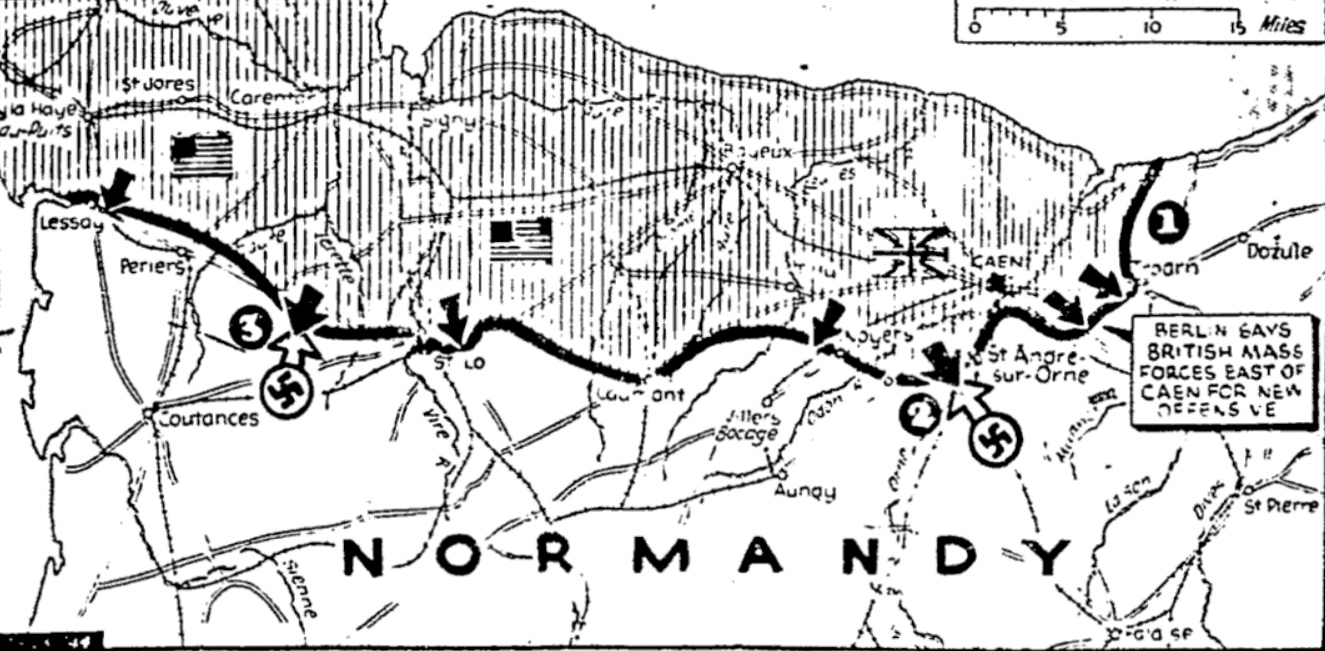The Pittsburgh Press (July 25, 1944)
Record airmada hits Nazis as Allies open new Normandy drive
By Virgil Pinkley, United Press staff writer

Striking south toward heart of Normandy, Allied forces have opened a new offensive. The British on the west (1) gained up to a mile and smashed into several villages as they advanced along both sides of the Caen–Falaise highway. The Americans started their attack several hours later either above Périers or below Saint-Lô (2), or in both sectors, and their gains were not announced immediately.
SHAEF, London, England –
The British 2nd Army drove forward more than a mile through two towns in a new offensive below Caen today, and to the west, the U.S. 1st Army launched an attack supported by 3,000 planes, including more than 1,500 U.S. heavy bombers – the biggest force ever dispatched on a single mission.
Both Allied armies bucked fierce German opposition in the synchronized assault toward the heart of Normandy, and the Nazi Air Force swarmed out in the greatest strength since D-Day to join in the defense of the ring around the Normandy beachhead.
Neither Allied headquarters nor limited field dispatches revealed where Lt. Gen. Omar N. Bradley’s troops made the new offensive, as on the British sector, they ran into desperate opposition, and early reports did not specify their gains.
The German DNB News Agency said the Americans were attacking below Carentan and were trying to drive across the Saint-Lô–Le Mesnil-Vigot highway. Le Mesnil-Vigot is 10 miles northwest of Saint-Lô.
Charge along highway
Gen. Sir Bernard L. Montgomery sent his infantry and tanks charging down southeast of Caen on a three-mile front astride the Falaise highway. In the first few hours, they overran Saint-Martin-de-Fontenay and Verrières, four to five miles below Caen, and were last reported fighting in nearby Tilly-la-Campagne.
Gen. Montgomery’s headquarters said the 2nd Army attack had limited objectives, and was not designed to smash entirely through the enemy fortifications blocking the way to the interior.
Street fighting in Tilly-la-Campagne and May-sur-Orne was going on when the last reports from the Normandy front reached headquarters late in the day. The British and Canadian assault forces were driving the Germans out house-by-house in bloody struggles.
Nazis bring up tanks
The Germans had thrown some tanks into the fighting, and may have a considerable number ready for a counterattack.
One unit reported it had knocked out at least four German tanks, and the total accounted for during the day was certain to be many more.
The British were supported heavily by the home-based Royal Air Force as well as Normandy-based fighters and fighter-bombers.
But that air effort paled in comparison with the all-American air assault on Bradley’s front. Spearheaded by more than 1,500 Flying Fortresses and Liberators, the U.S. armada included at a rough estimate 500 medium and light bombers and as many more fighter-bombers. Five hundred fighters escorted the heavies, power-diving to treetop level to rake the Nazi positions.
Drop 5,500 tons of bombs
U.S. planes laid an estimated 5,500 tons of explosives on the Germans immediately ahead of U.S. troops in an assault outweighing the bombardment of the Cassino fortifications in Italy.
The U.S. 8th and 9th Air Forces set out to “anaesthetize” the ground defenses at 10:00 a.m. (local time) with a torrent of fragmentation and lightweight explosives, used instead of heavier bombs in order to avoid plowing up the battlefield and making the infantry advance difficult.
The all-American air assault continued until 12:30 p.m. By then, the assault troops were battling forward.
One of biggest days
With the weather good, despite a slightly lower ceiling this afternoon, it seemed certain that the overall operations by the combined Allied air fleet would make this one of the biggest days aloft since the invasion of Normandy.
The day’s fighting was apparently confined to the two announced attacks. A headquarters spokesman had no evidence to support reports that fighting had flared up again in the area of Troarn, seven miles east of Caen.
The British attacked two hours before dawn and ran into tough opposition, which the Germans had had time to prepare after the fighting last week.
Terrain favors defenders
They had two and a half miles to fight uphill, and the country favored the defenders with small fields divided by walls and hedges.
United Press writer Richard D. McMillan said the German gunners and infantry were putting up most desperate resistance to the local attack. Some armored troops told him they had never known the enemy to fight so stubbornly.
The troops crept through cornfields wreathed in early morning mist and through rolling wheatfields. They took their first objectives when the tanks rolled in at dawn.
Into smoking villages
Mr. McMillan reported:
I watched the battle all morning, and saw batteries of self-propelled guns battering down enemy resistance while the tanks crept forward into smoking villages ahead.
A special announcement from U.S. Army headquarters in France said the 1st Army was “advancing against heavy resistance,” but gave no clue as to the scene of the attack. At last reports, the Americans had been massing for an advance across the Vire River below Saint-Lô and the Sèves River two miles north of Périers.

